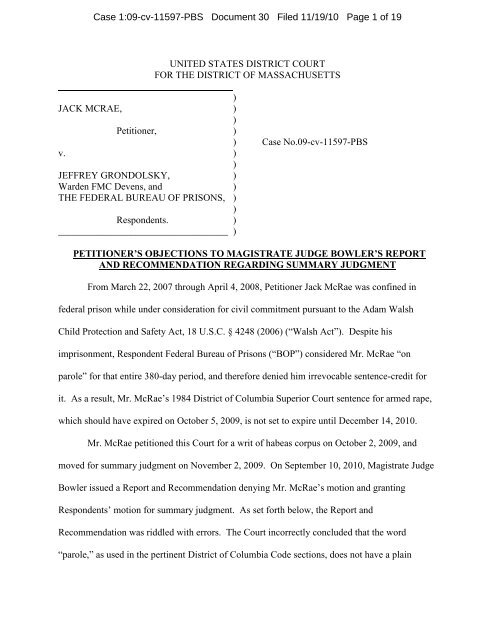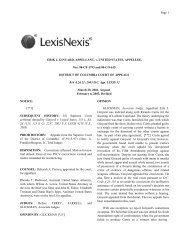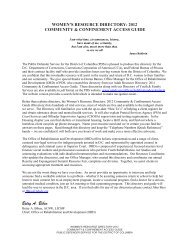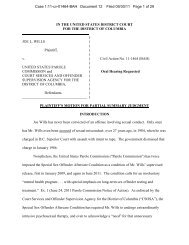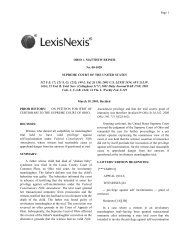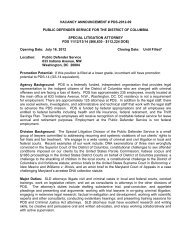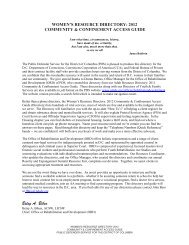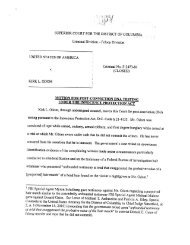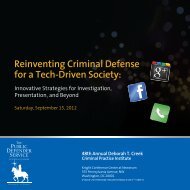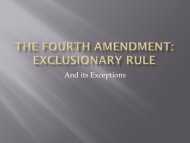Petitioner's Objections to Magistrate's Report & Recommendation
Petitioner's Objections to Magistrate's Report & Recommendation
Petitioner's Objections to Magistrate's Report & Recommendation
- No tags were found...
Create successful ePaper yourself
Turn your PDF publications into a flip-book with our unique Google optimized e-Paper software.
Case 1:09-cv-11597-PBS Document 30 Filed 11/19/10 Page 1 of 19<br />
UNITED STATES DISTRICT COURT<br />
FOR THE DISTRICT OF MASSACHUSETTS<br />
)<br />
JACK MCRAE, )<br />
)<br />
Petitioner, )<br />
) Case No.09-cv-11597-PBS<br />
v. )<br />
)<br />
JEFFREY GRONDOLSKY, )<br />
Warden FMC Devens, and )<br />
THE FEDERAL BUREAU OF PRISONS, )<br />
)<br />
Respondents. )<br />
___________________________________ )<br />
PETITIONER’S OBJECTIONS TO MAGISTRATE JUDGE BOWLER’S REPORT<br />
AND RECOMMENDATION REGARDING SUMMARY JUDGMENT<br />
From March 22, 2007 through April 4, 2008, Petitioner Jack McRae was confined in<br />
federal prison while under consideration for civil commitment pursuant <strong>to</strong> the Adam Walsh<br />
Child Protection and Safety Act, 18 U.S.C. § 4248 (2006) (“Walsh Act”). Despite his<br />
imprisonment, Respondent Federal Bureau of Prisons (“BOP”) considered Mr. McRae “on<br />
parole” for that entire 380-day period, and therefore denied him irrevocable sentence-credit for<br />
it. As a result, Mr. McRae‟s 1984 District of Columbia Superior Court sentence for armed rape,<br />
which should have expired on Oc<strong>to</strong>ber 5, 2009, is not set <strong>to</strong> expire until December 14, 2010.<br />
Mr. McRae petitioned this Court for a writ of habeas corpus on Oc<strong>to</strong>ber 2, 2009, and<br />
moved for summary judgment on November 2, 2009. On September 10, 2010, Magistrate Judge<br />
Bowler issued a <strong>Report</strong> and <strong>Recommendation</strong> denying Mr. McRae‟s motion and granting<br />
Respondents‟ motion for summary judgment. As set forth below, the <strong>Report</strong> and<br />
<strong>Recommendation</strong> was riddled with errors. The Court incorrectly concluded that the word<br />
“parole,” as used in the pertinent District of Columbia Code sections, does not have a plain
Case 1:09-cv-11597-PBS Document 30 Filed 11/19/10 Page 2 of 19<br />
meaning, and then deferred <strong>to</strong> the BOP‟s unreasonable interpretation of that term. The Court<br />
misconstrued a federal statute requiring that Mr. McRae be granted sentence-credit for the 380<br />
days in question and disregarded a District of Columbia statu<strong>to</strong>ry provision mandating the same<br />
result. Based on these errors, the Court improperly denied Petitioner‟s habeas corpus, Fifth<br />
Amendment, and Eighth Amendment claims and granted Respondents‟ motion for summary<br />
judgment.<br />
This Court should reject the magistrate judge‟s recommended disposition. It should issue<br />
an order res<strong>to</strong>ring <strong>to</strong> Mr. McRae the 380 days of sentence-credit <strong>to</strong> which he is entitled and<br />
declaring that Respondents violated his rights under the Fifth and Eighth Amendments <strong>to</strong> the<br />
Constitution.<br />
Factual Background<br />
Petitioner incorporates by reference his prior briefing of the facts of this case. See<br />
Emergency Petition for Writ of Habeas Corpus on Behalf of Jack McRae (DE # 1, “Pet.”) at 4-<br />
14; Memorandum in Support of Petitioner‟s Cross-Motion for Summary Judgment (DE # 13, “C-<br />
MSJ”) at 1; Petitioner‟s Reply <strong>to</strong> Respondents‟ Opposition <strong>to</strong> Summary Judgment (DE # 18,<br />
“Reply”) at 1. He summarizes below only those facts most pertinent <strong>to</strong> the instant pleading.<br />
On February 7, 1984, Mr. McRae was sentenced in District of Columbia Superior Court<br />
<strong>to</strong> a six-<strong>to</strong>-twenty-year term of imprisonment following his guilty plea <strong>to</strong> one count of rape while<br />
armed. Pet. at 4. He was manda<strong>to</strong>rily released in<strong>to</strong> the community in 1995. Id. On March 22,<br />
2006, 1 the USPC executed a parole viola<strong>to</strong>r warrant for Mr. McRae‟s arrest, based on allegations<br />
1 In the years between 1995 and 2006, Mr. McRae was twice re-incarcerated for violating<br />
technical conditions of his parole, and was re-paroled both times. Pet. at 7 n.3. Additionally, on<br />
August 5, 1997, Congress enacted the National Capital Revitalization and Self-Government<br />
Improvement Act, D.C. Code § 24-101 et seq. (“Revitalization Act”), which closed the prison<br />
facility operated by the District of Columbia Department of Corrections and mandated that all<br />
existing and future District of Columbia felons be designated <strong>to</strong> federal prisons across the<br />
2
Case 1:09-cv-11597-PBS Document 30 Filed 11/19/10 Page 3 of 19<br />
that he had consumed alcohol and failed <strong>to</strong> submit <strong>to</strong> drug testing in violation of the conditions<br />
of his parole. Id. at 7. The USPC revoked Mr. McRae‟s parole, ordered that he remain<br />
incarcerated for a 12-month term, and set a presumptive release date of March 22, 2007. Id. On<br />
March 20, 2007—two days prior <strong>to</strong> Mr. McRae‟s presumptive release date—the BOP certified<br />
Mr. McRae as a sexually dangerous person under the Walsh Act. Id. at 8. On March 22, 2007,<br />
the USPC issued a certificate of parole ordering Mr. McRae‟s release. Id. at 8-9.<br />
However, the BOP did not release Mr. McRae on March 22. Instead, it kept him in<br />
cus<strong>to</strong>dy pursuant <strong>to</strong> the Walsh Act, categorizing him as “a Pre-Trial inmate who is waiting <strong>to</strong> see<br />
the judge.” Id. at 9. Although he was now nominally a “parolee,” nothing about Mr. McRae‟s<br />
conditions of confinement changed—he was still imprisoned at FMC Devens, at the same<br />
security setting under which he had been confined prior <strong>to</strong> his March 22 “parole” date. Id. He<br />
remained there—incarcerated but “on parole” in the eyes of the BOP—for 380 days while<br />
awaiting a hearing under the Walsh Act. Id. Finally, on April 3, 2008, the United States<br />
At<strong>to</strong>rney submitted that it was not “in the interest of justice” <strong>to</strong> pursue Mr. McRae‟s commitment<br />
as a sexually dangerous person and dismissed his case prior <strong>to</strong> trial. Id. at 9-10. Mr. McRae was<br />
released in<strong>to</strong> the community on April 4, 2008. Id. at 10.<br />
Mr. McRae remained in the community under parole supervision until December 11,<br />
2008, when the USPC arrested him for violation of technical conditions of his parole. Id. Upon<br />
Mr. McRae‟s return <strong>to</strong> FMC Devens, the BOP did not give Mr. McRae sentence-credit for the<br />
380 days that he had spent confined awaiting a Walsh Act hearing. Id. at 12. Rather than<br />
acknowledging that Mr. McRae had been in prison for that period, which would have rendered<br />
country <strong>to</strong> serve their District of Columbia Superior Court-imposed sentences. Pet. at 4-5. The<br />
Revitalization Act also granted the United States Parole Commission (“USPC”) the authority <strong>to</strong><br />
grant, deny, and revoke the parole of District of Columbia felons. Id. at 5.<br />
3
Case 1:09-cv-11597-PBS Document 30 Filed 11/19/10 Page 4 of 19<br />
his time served non-rescindable, the BOP instead maintained that he had been “on parole” for the<br />
entire 380 days, which made his time served rescindable. Id.<br />
Had he been properly granted credit for the 380 days in question, Mr. McRae‟s maximum<br />
sentence for his 1984 offense would have expired on or about Oc<strong>to</strong>ber 5, 2009. Id. at 13.<br />
Instead, his maximum sentence is currently not set <strong>to</strong> expire until December 14, 2010. Pet.<br />
Appx. O (April 9, 2009 BOP sentence calculation). 2<br />
Procedural His<strong>to</strong>ry<br />
On Oc<strong>to</strong>ber 2, 2009, Mr. McRae filed an Emergency Petition for Writ of Habeas Corpus,<br />
in which he alleged that Respondents had improperly calculated his armed rape sentence under<br />
District of Columbia law; had deprived him of the due process of law under the Fifth<br />
Amendment; and would violate the Eighth Amendment by incarcerating him beyond Oc<strong>to</strong>ber 5,<br />
2009. DE # 1. Respondents filed a Motion <strong>to</strong> Dismiss and/or for Summary Judgment, DE #8<br />
(“Resp‟t MSJ”), and Petitioner filed a Cross-Motion for Summary Judgment, DE #12.<br />
Magistrate Judge Bowles heard oral argument on the motions on January 21, 2010, and issued a<br />
<strong>Report</strong> and <strong>Recommendation</strong> on September 10, 2010, DE # 24, in which she recommended that<br />
Respondents‟ Motion <strong>to</strong> Dismiss and/or for Summary Judgment be allowed and that Petitioner‟s<br />
Cross-Motion for Summary Judgment be denied. These objections follow. 3<br />
2 Mr. McRae was arrested on November 16, 2010 for violation of technical conditions of his<br />
parole, pursuant <strong>to</strong> a warrant issued on July 7, 2010. The expiration date for his maximum<br />
sentence thus may be pushed back further still.<br />
3 The magistrate judge gave the parties 14 days <strong>to</strong> object <strong>to</strong> her <strong>Report</strong> and <strong>Recommendation</strong>.<br />
R&R at 40 n.19. On September 23, 2010, this Court granted Petitioner‟s motion <strong>to</strong> extend the<br />
deadline for filing his objections until November 22, 2010.<br />
4
Case 1:09-cv-11597-PBS Document 30 Filed 11/19/10 Page 5 of 19<br />
Standard of Review<br />
The district judge reviews a magistrate judge‟s report and recommendation de novo. Fed.<br />
R. Civ. P. 72(b)(3). “The district judge may accept, reject, or modify the recommended<br />
disposition; receive further evidence; or return the matter <strong>to</strong> the magistrate judge with<br />
instructions.” Id.<br />
<strong>Objections</strong><br />
Mr. McRae objects <strong>to</strong> the magistrate‟s <strong>Report</strong> and <strong>Recommendation</strong> on four grounds:<br />
First, the Court wrongly concluded that “parole” has no plain meaning in the relevant D.C. Code<br />
sections and acceded <strong>to</strong> the BOP‟s unreasonable interpretation of that term. It therefore<br />
erroneously held that Mr. McRae was “on parole” for the 380 days that he spent imprisoned<br />
awaiting a Walsh Act hearing. Second, the Court misconstrued a federal statute, 18 U.S.C. §<br />
3568, requiring that Mr. McRae be granted sentence-credit for the 380 days in question. Third,<br />
the Court ignored D.C. Code § 24-221.03(c), which mandated the same result. Fourth, because<br />
of its mistaken conclusion regarding the calculation of Mr. McRae‟s sentence, the Court<br />
dismissed without full consideration Petitioner‟s Fifth Amendment and Eighth Amendment<br />
claims.<br />
I. The Court Incorrectly Determined That the 380 Days in Question Did Not<br />
Constitute “Parole” Under District of Columbia Law.<br />
Two District of Columbia statutes govern the sentence-credit granted <strong>to</strong> D.C. offenders<br />
for time spent in prison and on parole. 4<br />
Under the Good Time Credits Act of 1986 (“GTCA”),<br />
D.C. Code § 24-221.03, “Every person shall be given credit on the maximum and the minimum<br />
term of imprisonment for time spent in cus<strong>to</strong>dy or on parole in accordance with § 24-406, as a<br />
4 “Although the BOP is responsible for computing sentences of D.C. offenders housed in its<br />
facilities, the District of Columbia Code controls the computation of such sentences.” Kier v.<br />
Killian, No. 08 Civ. 0928, 2008 U.S. Dist. LEXIS 61552, at *16 (S.D.N.Y. Aug. 11, 2008).<br />
5
Case 1:09-cv-11597-PBS Document 30 Filed 11/19/10 Page 6 of 19<br />
result of the offense for which the sentence was imposed.” Under D.C. Code § 24-406(a) (2008),<br />
in the event that a prisoner‟s parole is revoked, “[t]he time a prisoner was on parole shall not be<br />
taken in<strong>to</strong> account <strong>to</strong> diminish the time for which he was sentenced.” 5<br />
Insofar as §24-221.03 and<br />
§ 24-406(a) are inconsistent—in that the former does not contemplate the possibility that credit<br />
for time spent on parole may be rescinded—the District of Columbia Court of Appeals has held<br />
that the latter provision controls. R&R at 21-22. The Court framed the question presented in<br />
light of these two statutes:<br />
If petitioner was „on parole‟ as of March 22, 2007, or the time spent confined under the<br />
Adam Walsh Act was „on parole,‟ the 380 days of credit can be rescinded through a<br />
straightforward application of D.C. Code § 24-406(a). If petitioner was „in prison,‟<br />
however, D.C. Code § 24-406(a) does not apply and the GTCA mandates that petitioner<br />
receive the full 380 days of credit.<br />
R&R at 23. However, having properly concluded that this matter turns on the meaning of<br />
“parole” in the relevant D.C. statutes, the Court quickly went astray in analyzing whether the<br />
BOP, using two USPC regulations as its guide, had appropriately interpreted that term as used in<br />
§24-221.03 and § 24-406(a). R&R at 23-31.<br />
To evaluate the BOP‟s interpretation of the term “parole,” the Court “look[ed] <strong>to</strong> the<br />
familiar two-part test enunciated in Chevron, U.S.A., Inc. v. Natural Res. Def. Council, 467 U.S.<br />
837, 842 (1984).” Id. at 24 (internal quotation marks omitted). Under Chevron‟s first step,<br />
courts must “employ the traditional <strong>to</strong>ols of statu<strong>to</strong>ry construction” <strong>to</strong> determine whether<br />
Congress “had an intention on the precise question at issue.” Chevron, 567 U.S. at 843 n.9. “If<br />
the intent of Congress is clear, that is the end of the matter; for the court, as well as the agency,<br />
must give effect <strong>to</strong> the unambiguously expressed intent of Congress.” Id. at 842-43. If, on the<br />
5 Section 24-406 was amended in 2009 so as no longer <strong>to</strong> require forfeiture of all credit for time<br />
spent “on parole” in the event of revocation. However, this change applied only <strong>to</strong> “any period<br />
of parole that is being served on or after May 20, 2009.” D.C. Code § 24-406(d) (2010).<br />
6
Case 1:09-cv-11597-PBS Document 30 Filed 11/19/10 Page 7 of 19<br />
other hand, “the statute is silent or ambiguous with respect <strong>to</strong> the specific issue,” courts are <strong>to</strong><br />
move on <strong>to</strong> Chevron‟s second step, where “the question for the court is whether the agency‟s<br />
[interpretation] is based on a permissible construction of the statute.” Id. at 843.<br />
The Court erred in moving beyond Chevron‟s first step. Although neither § 24-221.03<br />
nor § 24-406(a) defines “parole,” that term has a plain meaning—release from immediate<br />
physical confinement—such that there can be no question as <strong>to</strong> Congress‟s intent. “If, after<br />
employing all the traditional <strong>to</strong>ols of construction, the statue‟s text seems unambiguous and the<br />
ordinary meaning of that unambiguous language yields a reasonable result, the interpretive<br />
odyssey is at an end.” Morales v. Sociedad Espanola de Auxilio Mutuo y Beneficencia, 524 F.3d<br />
54, 57 (1 st Cir. 2008); see also Gen. Dynamics Land Sys., Inc. v. Cline, 540 U.S. 581, 600 (2004)<br />
(“Even for an agency able <strong>to</strong> claim all the authority possible under Chevron, deference <strong>to</strong> its<br />
statu<strong>to</strong>ry interpretation is called for only when the devices of judicial construction have been<br />
tried and found <strong>to</strong> yield no clear sense of congressional intent.”). Moreover, even if the term<br />
“parole” were ambiguous, so that the Court correctly proceeded <strong>to</strong> Chevron‟s second step, the<br />
BOP‟s interpretation of that term—based chiefly on a USPC regulation that characterizes<br />
“parole” solely by the issuance and signing of the certificate of parole—is not a “permissible<br />
construction” under Chevron. 567 U.S. at 843. The Court was thus wrong <strong>to</strong> endorse it.<br />
A. Because “Parole” Has a Plain Meaning, It Was Error for the Court <strong>to</strong> Move<br />
<strong>to</strong> Chevron’s Second Step.<br />
Black‟s Law Dictionary (8 th ed. 2004) defines “parole” as “[t]he release of a prisoner<br />
from imprisonment before the full sentence has been served.” Webster‟s gives a similar<br />
definition: “The conditional release of a prisoner before his or her term has expired.” Webster‟s<br />
II, New College Dictionary (2001). And the Supreme Court, consistent with the dictionaries, has<br />
recognized that parole is characterized by “release[] . . . from immediate physical<br />
7
Case 1:09-cv-11597-PBS Document 30 Filed 11/19/10 Page 8 of 19<br />
imprisonment.” Jones v. Cunningham, 371 U.S. 236, 242-43 (1963). Mr. McRae embraced<br />
these definitions as evidence of the plain meaning of “parole.” See C-MSJ at 8 (asserting that the<br />
“defining characteristic of parole” is “release from immediate physical imprisonment”); Reply at<br />
5 (citing dictionary definitions).<br />
The Court, however, declined <strong>to</strong> credit this authority and concluded instead that the<br />
relevant D.C. Code sections were “silent or ambiguous” as <strong>to</strong> the meaning of “parole.” R&R at<br />
27. It did so on two grounds: First, it discredited the sources on which Petitioner relied <strong>to</strong> define<br />
“parole.” Second, the Court held that Petitioner‟s definition was underinclusive, in that it failed<br />
<strong>to</strong> account for certain circumstances under which persons may be “on parole” yet still confined<br />
in prison, such as when federal parolees are subject <strong>to</strong> state or immigration detainers. Neither of<br />
these points has merit.<br />
1. Petitioner Properly Gleaned the Meaning of “Parole” Through<br />
Dictionary Definitions and Common Usage.<br />
The Court was generally dismissive of Petitioner‟s “attempts <strong>to</strong> ascertain Congressional<br />
intent through common, ordinary definitions of the term „parole.‟” R&R at 25. Such a plain<br />
meaning approach, however, is the one <strong>to</strong> which courts routinely turn when interpreting<br />
undefined statu<strong>to</strong>ry terms. See, e.g., Smith v. United States, 508 U.S. 223, 228 (1993) (“When a<br />
word is not defined by statute, we normally construe it in accord with its ordinary or natural<br />
meaning.”); Neang Chea Taing v. Napolitano, 567 F.3d 19, 24 (1 st Cir. 2009) (holding that in<br />
Chevron‟s first step, congressional intent should be gleaned from the “common, ordinary<br />
meaning of the words of the statute”); Textron Inc. v. Comm’r, 336 F.3d 26, 31 (1st Cir. 2003)<br />
(“The Supreme Court has repeatedly emphasized the importance of the plain meaning rule,<br />
stating that if the language of a statute or regulation has a plain and ordinary meaning, courts<br />
need look no further and should apply the regulation as it is written.”). Indeed, the Court itself<br />
8
Case 1:09-cv-11597-PBS Document 30 Filed 11/19/10 Page 9 of 19<br />
acknowledged the propriety of the plain meaning approach: “The [Chevron] analysis begins with<br />
the language of the statute in question. This entails examining the common, ordinary meaning of<br />
the words of the statute <strong>to</strong> determine Congressional intent.” R&R at 24 (quotation marks and<br />
citation omitted).<br />
More particularly, the Court faulted Mr. McRae‟s attempt <strong>to</strong> establish plain meaning<br />
through “references [<strong>to</strong>] dictionary definitions of „parole‟ that purportedly exhibit the common,<br />
ordinary meanings of the term.” R&R at 26. But the First Circuit has held that “[d]ictionaries of<br />
the English language are a fundamental <strong>to</strong>ol in ascertaining the plain meaning of terms used in<br />
statues and regulations.” United States v. Lachman, 387 F.3d 42, 51 (1 st Cir. 2004). Courts in<br />
this Circuit thus regularly rely on dictionaries <strong>to</strong> provide the plain meaning of statu<strong>to</strong>ry terms.<br />
See, e.g., Neang Chea Taing, 567 F.3d at 25 (relying on Black‟s Law Dictionary for “plain<br />
meaning” of undefined statu<strong>to</strong>ry term); Perez-Olivio v. Chavez, 394 F.3d 45, 49 (1 st Cir. 2005)<br />
(“Because Congress has chosen not <strong>to</strong> define the phrase [in question] in the statute itself, we can<br />
look <strong>to</strong> the dictionary for clarification of the plain meaning of the words selected by Congress.”);<br />
Textron, 336 F.3d at 32-33 (looking <strong>to</strong> Webster‟s Dictionary for plain meaning of regula<strong>to</strong>ry<br />
terms and discrediting party‟s analysis in part because it “does not cite . . . dictionary<br />
definitions”). 6<br />
The Court‟s critique of Mr. McRae‟s reliance on dictionary definitions is badly<br />
misplaced.<br />
The Court also faulted Mr. McRae for his reliance on common usage of the word<br />
“parole” as reflected in the caselaw. Mr. McRae cited Morrissey v. Brewer, 408 U.S. 471, 477<br />
6 The Supreme Court has just as regularly relied on dictionary definitions. See, e.g., Carey v.<br />
Saffold, 536 U.S. 214, 219-20 (2002) (rejecting party‟s reading of statu<strong>to</strong>ry term as inconsistent<br />
with Webster‟s definition, and thus ordinary meaning); MCI Telecomm. Corp. v. AT&T Co., 512<br />
U.S. 218, 225 (1994) (defining disputed term according <strong>to</strong> definition reflected in “[v]irtually<br />
every dictionary we are aware of”); Smith, 508 U.S. at 228-29 (looking <strong>to</strong> Black‟s and Webster‟s<br />
dictionaries <strong>to</strong> establish the “ordinary or natural meaning” of disputed term).<br />
9
Case 1:09-cv-11597-PBS Document 30 Filed 11/19/10 Page 10 of 19<br />
(1972), for instance, for its observation that “the function of parole in the correctional process” is<br />
the “practice of releasing prisoners . . . before the end of their sentences” and its holding that<br />
“[t]he essence of parole is release from prison, before the completion of sentence . . . .” See also<br />
Jones, 371 U.S. at 243 (observing that “petitioner‟s parole releases him from immediate physical<br />
imprisonment”). In the Court‟s view, with these and similar references, 7 “Petitioner place[d]<br />
undue emphasis . . . on qualifying the „essence‟ and „function‟ of parole.” R&R at 26. But it is<br />
beyond dispute that the common law is a reliable reference for the common usage of statu<strong>to</strong>ry<br />
language. See, e.g., Safeco Ins. Co. of Am. v. Burr, 551 U.S. 47, 57 (2007) (embracing<br />
construction of contested term that “reflects common law usage”); Jones v. R. R. Donnelley &<br />
Sons Co., 541 U.S. 369, 382-383 (2004) (adopting meaning of statu<strong>to</strong>ry term that “is consistent<br />
with our [previous] interpretations of the term”); Smith, 508 U.S. at 229 (giving deference <strong>to</strong><br />
“gloss” put on statu<strong>to</strong>ry term by Court “over 100 years ago”). And the “essence” and “function”<br />
of a concept (such as “parole”), which the Court criticized Mr. McRae for underscoring, are what<br />
most would call its plain meaning.<br />
The common law usage of “parole” is also consistent with the BOP‟s own definition of<br />
“parole” as “time spent in the community (street time).” BOP Program Statement 5880.32,<br />
ch. 17, p. 1 (Resp‟t MSJ, Ex. F). The Court rejected Mr. McRae‟s reliance on the Program<br />
Statement on the grounds that “[t]here is little, if any, indication that the BOP adopted this<br />
Program Statement utilizing the notice and comment procedures in the APA.” R&R at 28. But<br />
7 The common law is strewn with uses of “parole” that are in concert with Petitioner‟s definition.<br />
See, e.g., United States v. Estrella, 104 F.3d 3, 7 (1 st Cir. 1997) (“[I]t is doubtful that a paroled<br />
prisoner would normally be described as being in the cus<strong>to</strong>dy of a correctional institution.”<br />
(quotation marks omitted)); Brennan v. Cunningham, 813 F.2d 1, 5 (1 st Cir. 1987) (“An inmate<br />
in a halfway house . . . enjoys some significant liberty, [but] he remains under confinement in a<br />
correctional institution. His position is, therefore, not like that of a parolee.”); Sex<strong>to</strong>n v. Wise,<br />
494 F.2d 1176, 1178 (5 th Cir. 1974) (“Before a prisoner can be officially paroled, the final step of<br />
physical release must be taken.”).<br />
10
Case 1:09-cv-11597-PBS Document 30 Filed 11/19/10 Page 11 of 19<br />
even if the Program Statement does not carry the authority of an agency rule passed after notice<br />
and comment, it still provides further evidence that the plain, common meaning of “parole” is<br />
release from immediate physical confinement. See Smith, 508 U.S. at 243 (Scalia, J., dissenting)<br />
(observing that the “normal usage” of a disputed term “is reflected” in a United States<br />
Sentencing Commission Guidelines Manual). The fact that the BOP itself uses “parole” as Mr.<br />
McRae suggests it should be is yet another fact in support of his proffered definition.<br />
2. Petitioner’s Definition of “Parole” Is Not Underinclusive.<br />
The Court‟s second ground for rejecting Mr. McRae‟s definition of “parole” was that it is<br />
underinclusive, for “[n]ot all individuals who are granted parole are permitted <strong>to</strong> return <strong>to</strong> the<br />
community of <strong>to</strong> the street, such as federal parolees subject <strong>to</strong> state or immigration detainers.”<br />
R&R at 26; see also id. (“Petitioner places undue emphasis on the phrase „street time‟ . . . .”); id.<br />
at 26-27 (ascribing <strong>to</strong> Mr. McRae “[t]he assertion that all parolees must be returned <strong>to</strong> the<br />
community” and concluding that “[t]he definitions provided by petitioner overlook the fact that<br />
not all parolees are released <strong>to</strong> the street”). Mr. McRae has not, however, defined parole as<br />
“street time,” nor has he asserted that all parolees must be returned <strong>to</strong> the community. Instead,<br />
he has defined parole as “release from immediate physical imprisonment.” C-MSJ at 8. This<br />
definition, while appropriately emphasizing that parolees are most frequently released in<strong>to</strong> the<br />
community, nevertheless also embraces the two circumstances <strong>to</strong> which the Court pointed—state<br />
and immigration detainers—under which federal parolees are released in<strong>to</strong> the cus<strong>to</strong>dy of<br />
another authority. In all events, parolees are released from the immediate physical cus<strong>to</strong>dy of the<br />
authority that has been holding them. It is that release—whether in<strong>to</strong> the community or in<strong>to</strong> the<br />
cus<strong>to</strong>dy of another authority—that is the <strong>to</strong>uchs<strong>to</strong>ne of parole. Cf. 28 C.F.R. § 2.32(c)<br />
(“„[P]arole <strong>to</strong> a detainer‟ means release <strong>to</strong> the „physical cus<strong>to</strong>dy‟ of the authorities who have<br />
11
Case 1:09-cv-11597-PBS Document 30 Filed 11/19/10 Page 12 of 19<br />
lodged the detainer.” (emphasis added)). Because Mr. McRae was not released subject <strong>to</strong> a state<br />
or immigration detainer, but instead remained in the physical cus<strong>to</strong>dy of the BOP during the<br />
relevant 380 days, he was never paroled.<br />
B. Even if the Court Was Correct <strong>to</strong> Move <strong>to</strong> Chevron’s Second Step, It Should<br />
Have Found the BOP’s Interpretation of “Parole” Unreasonable.<br />
Even if the Court correctly held that “parole” has no plain meaning, it still should have<br />
rejected the BOP‟s interpretation of that term because it was not “based on a permissible<br />
construction of the statute.” Chevron, 406 U.S. at 843; see also id. at 843 n.9 (“The judiciary is<br />
the final authority on issues of statu<strong>to</strong>ry construction and must reject administrative constructions<br />
which are contrary <strong>to</strong> clear congressional intent.”).<br />
The BOP‟s interpretation of “parole,” embraced by the Court, relies on a pair of USPC<br />
regulations. It places chief emphasis on 28 CFR § 2.86(e), which states, “A grant of parole<br />
becomes operative upon the authorized delivery of a certificate of parole <strong>to</strong> the prisoner, and the<br />
signing of that certificate by the prisoner, who thereafter becomes a parolee.” The BOP takes<br />
this language and runs with it, contending that parole is characterized solely by its technical<br />
onset: “Time after [the certificate is signed] is time spent „on parole.‟” Resp‟t MSJ at 14. This<br />
form-over-substance position, which does not contemplate whether or where the “parolee” is still<br />
confined after he signs the parole certificate, leaves <strong>to</strong>o much room for absurd results. 8<br />
See<br />
Griffin v. Oceanic Contrac<strong>to</strong>rs, 458 U.S. 564, 575 (1982) (“[I]nterpretations of a statute which<br />
would produce absurd results are <strong>to</strong> be avoided if alternative interpretations consistent with the<br />
legislative purpose are available.”); Gen’l Mo<strong>to</strong>rs Corp. v. Darling’s, 444 F.3d 98, 108 (1 st Cir.<br />
8 BOP‟s reliance on § 2.86 is made even more of a stretch by the fact that, as Mr. McRae has<br />
previously noted, that section does not even purport <strong>to</strong> define the term “parole.” See Reply at 3.<br />
The section merely affirms the USPC‟s authority <strong>to</strong> rescind an earlier grant of parole up until the<br />
moment when a parole certificate is delivered and signed by a prisoner—and it has only been<br />
cited as authority for that single proposition. Id.<br />
12
Case 1:09-cv-11597-PBS Document 30 Filed 11/19/10 Page 13 of 19<br />
2006) (courts should “avoid statu<strong>to</strong>ry constructions that create absurd, illogical, or inconsistent<br />
results”). For instance, under the BOP‟s view, a prisoner who signs a certificate of parole but<br />
through administrative error is held in the same prison, under the same conditions, for the next<br />
sixty years, is not a lifelong prisoner but a lifelong parolee. Mr. McRae‟s plight, wherein he has<br />
received no sentence credit, in any form, for more than a year served in prison, is less absurd<br />
only as a matter of degree. 9<br />
Nonetheless, the Court favored the BOP‟s stiff logic over Mr.<br />
McRae‟s plain meaning analysis: “Petitioner‟s arguments concerning qualitative aspects of<br />
„parole‟ are surpassed by the simple fact that petitioner was granted parole by the USPC and was<br />
therefore on parole.” R&R at 31. That is, Mr. McRae was on parole because the government<br />
says he was.<br />
The second USPC regulation on which the BOP relies is 28 CFR § 2.105(d) (2008),<br />
which holds that time spent on parole can include “time the parolee may have spent in<br />
confinement on other sentences.” 10<br />
According <strong>to</strong> the Court, this supports the BOP‟s position that<br />
Mr. McRae was on parole while under Walsh Act confinement because “[c]onfinement on other<br />
sentences logically extends <strong>to</strong> confinement under a civil commitment order.” R&R at 30. This<br />
conclusion, which the Court supports with neither authority nor analysis, is flawed. Mr. McRae<br />
was not confined “under a civil commitment order.” Instead, he was confined pending a hearing<br />
on whether he should be civilly committed—and that hearing never occurred. There was thus no<br />
“order” that even arguably could have led <strong>to</strong> “[an]other sentence[].” This is underscored by the<br />
9 The BOP‟s interpretation also has the perverse result of punishing those inmates who, like Mr.<br />
McRae, are fully compliant during their time in prison. See C-MSJ at 12-13 (noting that whereas<br />
sentence will continue <strong>to</strong> run, and sentence-credit <strong>to</strong> accrue, for inmate certified under Walsh Act<br />
whose parole release date is rescinded for in-prison misconduct, it will not for compliant<br />
prisoner, like Mr. McRae, who is in fact granted “parole” while awaiting Walsh Act hearing).<br />
10 This language was removed from 28 CFR § 2.105(d) in 2009 when the regulation was<br />
amended <strong>to</strong> mirror the amendment <strong>to</strong> D.C. Code § 24-406. See supra, note 5.<br />
13
Case 1:09-cv-11597-PBS Document 30 Filed 11/19/10 Page 14 of 19<br />
fact that Mr. McRae‟s Walsh Act confinement flowed directly from, and depended directly upon,<br />
his 1984 sentence. Mr. McRae was only eligible <strong>to</strong> be certified under the Walsh Act because he<br />
was “in the cus<strong>to</strong>dy of the Bureau of Prisons,” 18 U.S.C. § 4248(a), and the only offense for<br />
which he was in the cus<strong>to</strong>dy of the Bureau of Prisons was his 1984 conviction. By no stretch,<br />
then, were the 380 days in question in service of a sentence “other” than the one he received for<br />
the 1984 conviction.<br />
II.<br />
The Court Misconstrued 18 U.S.C. § 3568, Which Mandates that Mr. McRae Be<br />
Given Sentence-Credit for the 380 Days.<br />
18 U.S.C. § 3568, which the BOP itself argues applies <strong>to</strong> Mr. McRae‟s sentence, Resp‟t<br />
MSJ at 16, provides an independent reason why Mr. McRae should be credited for the time in<br />
question. Under that section, which governed the jail credit given <strong>to</strong> D.C. offenders sentenced<br />
from June 22, 1966 <strong>to</strong> April 10, 1987, “The At<strong>to</strong>rney General shall give any such person credit<br />
<strong>to</strong>ward service of his sentence for any days spent in cus<strong>to</strong>dy in connection with the offense or<br />
acts for which sentence was imposed.” 18 U.S.C. § 3568 (repealed) (emphasis added). As<br />
explained above, Mr. McRae‟s Walsh Act confinement was only possible by virtue of his 1984<br />
conviction. Moreover, in its Walsh Act certification, the BOP cited Mr. McRae‟s 1984<br />
conviction as chief among the reasons why he was deemed sexually dangerous. See Resp‟t MSJ<br />
Ex. I. The Walsh Act confinement was thus, by definition, “in connection with” the 1984<br />
conviction. See United States v. Thompson, 32 F.3d 1, 5 (1st Cir. 1994) (defining “connection,”<br />
in accordance with Webster‟s Dictionary, as a “causal or logical relation or sequence”).<br />
The Court disagreed, concluding that “[c]ommitment pursuant <strong>to</strong> section 4248 of the<br />
Adam Walsh Act is not cus<strong>to</strong>dy in connection with [his] underlying 1984 conviction,” and<br />
therefore that Mr. McRae is not due sentence-credit under § 4248. R&R at 33. The Court cited<br />
Kansas v. Hendricks, 521 U.S. 346 (1997), in support of its view, but that case is inapposite.<br />
14
Case 1:09-cv-11597-PBS Document 30 Filed 11/19/10 Page 15 of 19<br />
Hendricks “dealt with a [Kansas] statute whose elements are similar <strong>to</strong> those of the Adam Walsh<br />
Act” and, in the Court‟s view, drew a distinction between civil commitment and underlying<br />
criminal conduct. R&R at 33-34. However, Hendricks is distinguishable from the instant case<br />
on a fundamental ground: the Kansas statute at issue in Hendricks “does not make a criminal<br />
conviction a prerequisite for commitment.” Hendricks, 521 U.S. at 362. This is in contrast <strong>to</strong><br />
Walsh Act confinement, for which, as the Court itself held, “a past criminal conviction for a<br />
sexually violent offense is a necessary prerequisite.” R&R at 33. The fact that the Hendricks<br />
Court arguably drew a line between a past conviction and present civil commitment thus has no<br />
bearing on whether such a line exists under the facts of this case.<br />
As Mr. McRae pointed out in his briefs, the more germane authority comes from United<br />
States v. DeBellis, 649 F.2d 1 (1 st Cir. 1981). See C-MSJ at 17-18. There, the First Circuit<br />
granted the defendant sentence-credit for his time spent in pre-trial civil commitment because it<br />
qualified, under § 3568, as “time spent in cus<strong>to</strong>dy in connection with the offense or acts for<br />
which the sentence was imposed.” Id. at 2 (emphasis added). The Court attempted <strong>to</strong><br />
distinguish DeBellis on the grounds that the civil commitment there was “pre-trial detention for<br />
competency evaluation[],” R&R at 34, but it provided no explanation of why that distinction<br />
makes a difference. There is no reason why time spent awaiting a pre-trial evaluation is any<br />
further “in connection” with an eventual sentence than time spent awaiting Walsh Act evaluation<br />
is with a predicate sentence. And any distinction between the two periods of confinement is<br />
further blurred by the fact that the BOP itself deemed Mr. McRae “a Pre-Trial inmate” during his<br />
Walsh Act confinement. Pet. at 9.<br />
15
Case 1:09-cv-11597-PBS Document 30 Filed 11/19/10 Page 16 of 19<br />
III.<br />
The Court Ignored a District of Columbia Statu<strong>to</strong>ry Basis for Granting Mr. McRae<br />
Sentence-Credit.<br />
There is a second, independent statu<strong>to</strong>ry basis for granting Mr. McRae credit for the 380<br />
days, this one in D.C. law. Under the GTCA, “Any person who is sentenced <strong>to</strong> a term of<br />
confinement in a correctional facility or hospital shall have deducted from the term all time<br />
actually spent, pursuant <strong>to</strong> a court order, by the person in a hospital for examination purposes or<br />
treatment prior <strong>to</strong> trial or pending appeal.” D.C. Code § 24-221.03(c). Mr. McRae was<br />
unquestionably “sentenced <strong>to</strong> a term of a confinement in a correctional facility,” and he spent the<br />
380 days in question in Federal Medical Center Devens awaiting “a hearing <strong>to</strong> determine<br />
whether [he was] a sexually dangerous person,” 18 U.S.C. § 4248(a). During that time, he was<br />
categorized by the BOP as “a Pre-Trial inmate who is waiting <strong>to</strong> see the judge.” Pet. at 9. Mr.<br />
McRae was thus being held “for examination purposes . . . prior <strong>to</strong> trial” under § 24-221.03(c);<br />
accordingly, he should “have deducted from [his] term all time” spent in such confinement. 11<br />
It is true that Mr. McRae does not meet the requirements of the GTCA <strong>to</strong> the letter: he<br />
was confined for the period in question pursuant <strong>to</strong> the BOP‟s Walsh Act certification, not “a<br />
court order.” But the District of Columbia Court of Appeals has construed § 24-221.03(c)<br />
broadly. In Shel<strong>to</strong>n v. United States, 721 A.2d 603, 610 (D.C. 1998), the Court of Appeals<br />
considered whether a prisoner committed pursuant <strong>to</strong> the Sexual Psychopath Act was due credit<br />
under that section despite the fact that his confinement was neither “prior <strong>to</strong> trial” nor “pending<br />
11 This view finds support beyond § 24-221.03(c), in both the caselaw and the BOP‟s own<br />
internal guidelines. See McNeil v. Patuxent Institution, 407 U.S. 245, 252 (1972) (granting<br />
petitioner credit <strong>to</strong>wards his sentence for time spent in cus<strong>to</strong>dy under examination for civil<br />
commitment); Cephus v. United States, 389 F.2d 317 (D.C. Cir. 1967) (granting appellant<br />
sentence-credit for pre-trial confinement in hospital for mental examination); BOP Program<br />
Statement 5880.28, ch. 2, p. 12 (if a prisoner serving a sentence undergoes examination <strong>to</strong><br />
determine if he is suffering from a mental disease or defect, “the person is serving a sentence<br />
during the examination”); BOP Program Statement 5880.32, ch. 6, p. 1 (The sentence of a<br />
prisoner committed for examination under D.C. Code § 24-302 “will not become inoperative.”).<br />
16
Case 1:09-cv-11597-PBS Document 30 Filed 11/19/10 Page 17 of 19<br />
appeal.” The court held that, even though “the subsection does not literally cover the case before<br />
us,” petitioner was indeed entitled <strong>to</strong> credit, for there was “no indication that the legislature<br />
intended <strong>to</strong> occupy the field by the precise terms of 24-431(c).” 12 Id. at 611.<br />
Had the Court considered § 24-221.03(c), it would have been bound by the D.C. Court of<br />
Appeals‟ broad construction of it in Shel<strong>to</strong>n, for federal courts “ha[ve] no authority <strong>to</strong> construe<br />
the language of a state statute more narrowly than the construction given by that State‟s highest<br />
court.” City of Chicago v. Morales, 527 U.S. 41, 61 (1999). However, the Court never<br />
addressed Mr. McRae‟s § 24-221.03(c) argument in its <strong>Report</strong> and <strong>Recommendation</strong>. That was<br />
error, <strong>to</strong> which Mr. McRae objects.<br />
IV.<br />
The Court’s Error on Mr. McRae’s Claim <strong>to</strong> Credit for the 380 Days Infected Its<br />
<strong>Recommendation</strong>s as <strong>to</strong> His Fifth Amendment and Eighth Amendment Claims.<br />
Based on her holding that Mr. McRae had not been improperly deprived of 380 days of<br />
sentence-credit, the magistrate judge summarily dismissed Mr. McRae‟s Fifth Amendment and<br />
Eighth Amendment claims. See R&R at 39 (“The liberty interest in being free from bodily<br />
restraint does not extend <strong>to</strong> a prisoner seeking release prior <strong>to</strong> the end of his prison sentence.”);<br />
id. at 37 (“[B]ecause petitioner will not remain incarcerated beyond the true expiration of his<br />
1984 sentence, there is no Eighth Amendment violation.”). A rejection by this Court of the<br />
magistrate judge‟s recommendation on the sentence-credit issue would thus breathe life in<strong>to</strong> Mr.<br />
McRae‟s two constitutional claims. For all of the reasons set forth in Mr. McRae‟s Emergency<br />
Petition and the briefs filed in support of it, this Court should issue a declaration that<br />
Respondents violated his rights under the Fifth and Eighth Amendments <strong>to</strong> the Constitution.<br />
12 24-431(c) is now codified at 24-221.03(c).<br />
17
Case 1:09-cv-11597-PBS Document 30 Filed 11/19/10 Page 18 of 19<br />
Conclusion<br />
For the reasons stated, this Court should reject the magistrate judge‟s recommended<br />
disposition. It should issue an order res<strong>to</strong>ring <strong>to</strong> Mr. McRae the 380 days of sentence-credit <strong>to</strong><br />
which he is entitled and declaring that Respondents violated his rights under the Fifth and Eighth<br />
Amendments <strong>to</strong> the Constitution.<br />
Respectfully submitted,<br />
/s/ Sandra K. Levick _______________________<br />
Sandra K. Levick, D.C. Bar No. 358630<br />
(admitted pro hac vice)<br />
Special Litigation Division<br />
Public Defender Service for the District of Columbia<br />
633 Indiana Ave., NW<br />
Washing<strong>to</strong>n, D.C. 20004<br />
Date: November 19, 2010<br />
/s/ David A. Taylor_________________________<br />
David A. Taylor, D.C. Bar No. 975974<br />
(pro hac vice application pending)<br />
Special Litigation Division<br />
Public Defender Service for the District of Columbia<br />
633 Indiana Ave., NW<br />
Washing<strong>to</strong>n, D.C. 20004<br />
18
Case 1:09-cv-11597-PBS Document 30 Filed 11/19/10 Page 19 of 19<br />
CERTIFICATE OF SERVICE<br />
I hereby certify that the foregoing <strong>Objections</strong> were filed through the Electronic Court<br />
Filing system and will be sent electronically <strong>to</strong> the registered participants as identified on the<br />
Notice of Electronic Filing.<br />
/s/ Sandra K. Levick<br />
Sandra K. Levick<br />
_<br />
Date: November 19, 2010<br />
19


